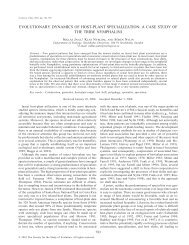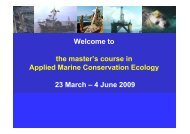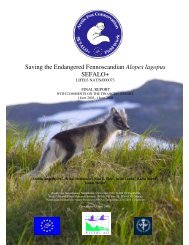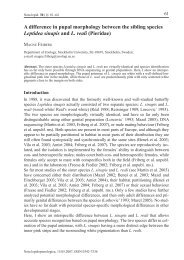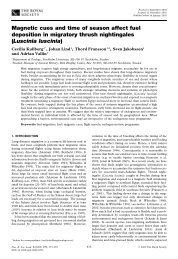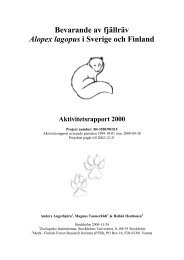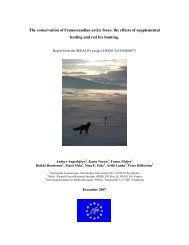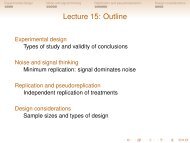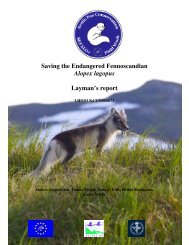Evolution of Fighting Behaviour: The Effect of Variation in Resource ...
Evolution of Fighting Behaviour: The Effect of Variation in Resource ...
Evolution of Fighting Behaviour: The Effect of Variation in Resource ...
Create successful ePaper yourself
Turn your PDF publications into a flip-book with our unique Google optimized e-Paper software.
GAMES WITH VARIATION IN RESOURCE VALUE 195B is slightly stronger, and contests won by B will tend to be longer than those wonby A. In Fig. 2 we illustrate how this affects the expected length <strong>of</strong> contests betweenan <strong>in</strong>dividual with subjective resource value V and a random opponent.If the cost <strong>of</strong> acquir<strong>in</strong>g <strong>in</strong>formation about relative fight<strong>in</strong>g ability is decreased,either by decreas<strong>in</strong>g cr or c, the ESS changes so that the switch<strong>in</strong>g l<strong>in</strong>es come closertogether <strong>in</strong> the causal factor space. <strong>The</strong> effect <strong>of</strong> this will be that the outcomes <strong>of</strong>fights will be more determ<strong>in</strong>ed by relative fight<strong>in</strong>g ability than by asymmetries <strong>in</strong>subjective resource value. Increas<strong>in</strong>g cr and/or c will have the reverse effect <strong>of</strong><strong>in</strong>stead spread<strong>in</strong>g out the switch<strong>in</strong>g l<strong>in</strong>es more, but for sufficiently large o- or c theESS changes qualitatively, and <strong>in</strong>dividuals with small V will decl<strong>in</strong>e to fight (e.g.this will happen if o" is <strong>in</strong>creased to 1-0 <strong>in</strong> our example). Increas<strong>in</strong>g the range <strong>of</strong>variation <strong>of</strong> subjective resource value <strong>in</strong> the population or decreas<strong>in</strong>g the range <strong>of</strong>variation <strong>of</strong> relative fight<strong>in</strong>g ability has a similar effect on the ESS, mak<strong>in</strong>g theoutcomes <strong>of</strong> fights more determ<strong>in</strong>ed by asymmetry <strong>in</strong> subjective resource value thanasymmetry <strong>in</strong> fight<strong>in</strong>g ability.Second Example: Information AsymmetryA common contest situation where one can expect <strong>in</strong>formation asymmetries isan owner-<strong>in</strong>truder <strong>in</strong>teraction. <strong>The</strong> owner, hav<strong>in</strong>g spent some time at the resource,will <strong>of</strong>ten be better <strong>in</strong>formed about the resource than the <strong>in</strong>truder. To study this,let us consider a situation where there are no differences among animals regard<strong>in</strong>gtheir physiological state, but where the amount <strong>of</strong> resource varies among contests.<strong>The</strong> owner knows the exact value <strong>of</strong> the resource, whereas the <strong>in</strong>truder does nothave this <strong>in</strong>formation. For a sequential assessment game, this means that the <strong>in</strong>trudercan base its decisions only on two causal factors (apart from the role), namely,estimate <strong>of</strong> relative fight<strong>in</strong>g ability (x) and fight<strong>in</strong>g time (n). An owner can, however,also base its decisions on the value <strong>of</strong> the resource. Thus, there will be only onelocal strategy with respect to resource value for <strong>in</strong>truders, whereas there might beone for each amount <strong>of</strong> resource for owners. This does not mean that the <strong>in</strong>truderwill get no <strong>in</strong>formation about the resource dur<strong>in</strong>g a fight, but that this <strong>in</strong>formationwill come only through estimate <strong>of</strong> relative fight<strong>in</strong>g ability and fight<strong>in</strong>g time. Forsimplicity, we will <strong>in</strong> our example exclude several other asymmetries that are likelyto occur <strong>in</strong> nature (for <strong>in</strong>stance, differences <strong>in</strong> average fight<strong>in</strong>g ability betweenowners and <strong>in</strong>truders; see Leimar & Enquist (1984)). Note that <strong>in</strong> this case theexpected resource value for the <strong>in</strong>truder depends on the <strong>in</strong>truder's strategy. Acautious <strong>in</strong>truder only w<strong>in</strong>s resources <strong>of</strong> low value whereas a persistent <strong>in</strong>truderalso w<strong>in</strong>s valuable resources.We have analysed a case with a discrete distribution <strong>of</strong> amount <strong>of</strong> resource witheleven classes correspond<strong>in</strong>g to resource values vary<strong>in</strong>g from V=0-5 to V= 1.5with <strong>in</strong>crement 0.1 and with equal frequency for each class. <strong>The</strong> prior distribution<strong>of</strong> relative fight<strong>in</strong>g ability (fl(O)) is normal with standard deviation 0.5 and otherparameter values are o- = 1.5 and c -- 0.05. Only one ESS was found, and this ESSis shown <strong>in</strong> Fig. 3 (we were not able to f<strong>in</strong>d alternative ESS's, as for <strong>in</strong>stancesometh<strong>in</strong>g like a paradoxical ESS).



